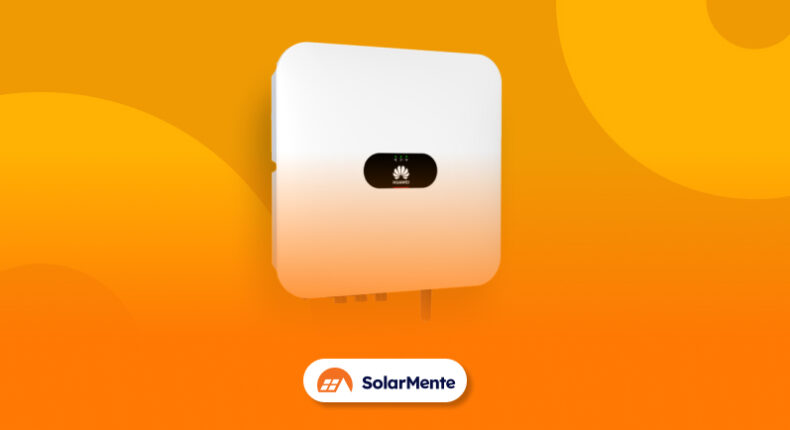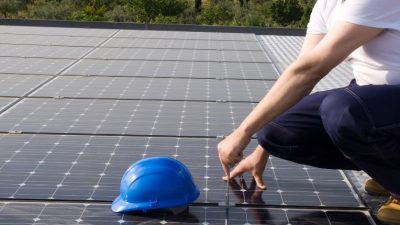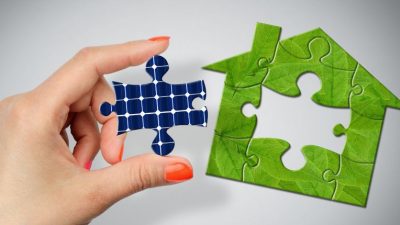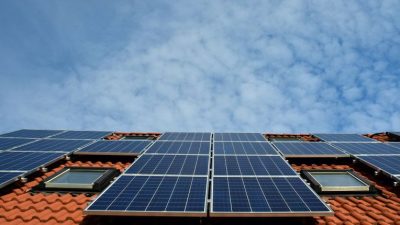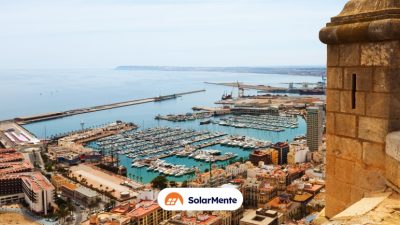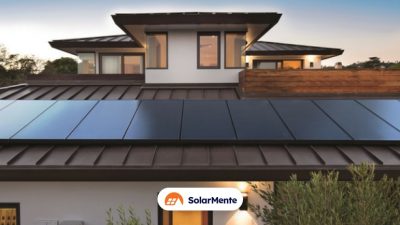Solar panels are an important part of the system, but we often forget the brain or engine of the installation: the solar inverter.
It is a less recognised component in self-consumption installations and its function is very important to be able to consume the electricity generated by solar energy, converting it into electrical energy suitable for our homes.
Today we are going to see:
- What is a solar inverter and how it works.
- Types of solarinverters on the market.
- How much does a solar invertercost.
What is a solar inverter and how does it work?
The solar inverter is the element that cannot be missing in any solar panel installation. Without the existence of this component, we would not be able to enjoy the electricity generated by our photovoltaic system, as it converts the energy into electricity suitable for household consumption.
It sounds very simple, doesn’t it?
We are going to explain it in depth so that you have no doubts about it.
Well, this is the step-by-step operation of solar inverters in a photovoltaic self-consumption installation.
First, the solar panels receive light from the sun that will be transformed into electricity.
So far so good, but can this energy be consumed just like that?
The energy generated cannot be consumed directly because we are talking about direct current. To do this, we need to transform this energy into alternating current that is already available for use in the lighting and electrical appliances in our home.
And what is the element that performs this function? The solar inverter.
Therefore, thanks to this component of the system, direct current is transformed into alternating current for domestic use.
Let us tell you more: not only is it responsible for transforming the energy for our daily energy consumption, but it also optimises the energy production generated by the solar panels in order to maximise the performance of the photovoltaic system.
During this process, it is important that all other elements function correctly. By this, we mean electrical circuits in the house, fuses and even the inverter itself.
To carry out a good installation, we recommend that you turn to professionals in the sector. At SolarMente, we accompany you throughout the process and answer all your questions at every stage of the procedure.
4 benefits that you will get with a solar inverter
If we look back, the data has changed significantly.
In 1956, the efficiency of solar panels was only 6% and they cost around 300 euros per watt. That’s a price that makes the hair on the back of your neck stand on end.
Since then, technological developments in solar panels and inverters for self-consumption have managed to increase efficiency to 18% without leaving our pockets shivering.
But you should know that a solar inverter not only transforms direct current into alternating current for the use of our electronic devices, but also provides us with another series of benefits that we will tell you about below:
- It maximises the power of the solar panels to generate more electricity and, of course, as clean as possible.
- It monitors the performance of the photovoltaic system. It allows us to find out how much energy is being produced via a mobile app. However, it also helps us to find out if there are any faults in the panels and to make the appropriate repairs to prevent the yield from decreasing further.
- In the event of temporary power outages, the solar inverters do not transmit the electricity generated by the system to the grid and therefore the workers repairing the grid are not at risk.
- The system will stop producing power as soon as a short circuit or other system failureoccurs.
How many types of solar inverter are there?
Without a solar inverter, there is little or nothing we can do to make use of the electricity from the sun. In other words, we could say that it is the brain of the installation.
But of course, not all inverters are the same. So we are going to explain the different options you can find on the market, taking into consideration the advantages and disadvantages of each one in order to evaluate and make the best decision.
The types of inverters are classified according to the following criteria:
- Depending on the power and electrical configuration.
- Depending on the application of the system.
We begin with inverters according to the installed power: single-phase and three-phase inverters. Let’s see in which situations each of them are used.
Single-phase inverters
Single-phase inverters use only one phase and a single alternating current.
This type of installation is usually 230 volts to install a maximum power of 14.49 kW. It is the most common in homes in Spain for heating and lighting. The implementation also has a lower cost.
When we talk about one phase, it means that the electricity produced by solar energy is transferred with the same current.
We know, now you are curious to know if your installation is single-phase or not. Is there any way to find out? Of course there is. And it is very simple. Go to your electrical panel and check that the devices are double.
Three-phase inverters
Three-phase inverters, on the other hand, have 3 phases and 3 alternating currents and the voltage is around 400 volts.
You will have noticed that the volts from one inverter to another is almost double. This is because this type of installation is used in homes where the energy consumption is higher due to the installation of swimming pools or for industries and companies where the photovoltaic installations are larger and need more power.
If our home has an inverter of these characteristics, we will once again go to our electrical panel and we will see a triple device.
Inverters with grid connection
First criterion completed.
Let us move on to the second criterion. In this case, we can differentiate between two main groups:
- Grid-connected inverters: subject to the electricity company.
- Solar inverters for off-grid systems: absolute independence from the electricity grid with the use of solar batteries.
We are going to analyse the first case. This type of inverter maintains the connection to your electricity company and, therefore, you will be able to feed the surpluses into the electricity grid, thus obtaining economic compensation.
In fact, the inverter works like a brain and it is the one who makes the final decision on where to consume, i.e. from the panels, batteries or electricity grid to have energy at home.
That said, let’s evaluate the pros and cons of each type of inverter:
- String
- Microinverters
- Power optimisers
- Smart modules
String inverters
String or centralised inverters are used for solar panel installations where the system is not affected by shading.
Today, they are the most economical and widely used in homes across the country as they require little or no maintenance.
Installation is simple, access is easy and there is no additional cost.
However, the way they work is as follows. In installations with string inverters, the solar panels are connected in a series or string (hence the name) that converts direct current into alternating current for household energy consumption.
The problem with this photovoltaic inverter is that the low yield of one panel can affect the remaining panels in the string, limiting energy production to the one that has generated the least power.
In short, if the solar panels are affected by shading at certain times of the year, the total power output will be clearly reduced to the output of that panel that is affected by shading.
Therefore, it is a good investment for regions where houses receive constant sunlight and are not affected by shading.
Microinverters
What is the main difference between string inverters and microinverters?
String inverters are central inverters and the performance of one panel will have an impact on the other panels in the string, whereas micro inverters are small elements that are installed on each solar panel and distributed throughout the PV system.
What do we mean by this?
The output is not directed to a single centralised inverter, but each panel transforms the electricity from direct current to alternating current from the roof itself.
This brings a very clear benefit: the production of a single panel will not affect the rest, thus decreasing the yield of the whole installation.
This is a good option for homes where shading is uniform and these effects can be mitigated so as not to have a noticeable drop in performance. In addition, you can monitor the solar panels in case they are affected by incidents in the system.
It is more efficient and allows the system to be expanded in the future if necessary, as the microinverter is individual.
However, not everything is rosy. There is a small disadvantage called price, since they are embedded individually in each panel and, in case of repair, it is more complicated. The access facilities are not the same.
What we can assure you is that if you live in a geographic area with shadows, you will be able to take advantage of the performance of your system and still produce energy for your home.
If not, try our self-consumption calculator and find out how much you can save on your electricity bill by installing solar panels.
Power optimisers
Power optimisers are a combination of micro inverters and string inverters.
They take the best of each for one simple reason.
These types of inverters are also embedded in each of the solar panels as is the case with micro inverters, but they do not produce energy directly from the modules. Instead, the energy produced is sent to a centralised inverter, just like string inverters.
They are very efficient because they locate the panel that generates the most power and affect the performance of one over the whole system.
This means that if the shadow lurks on any of our panels, the system will not reduce the performance considerably because of the optimiser.
Why are they an interesting option? Their cost is lower than microinverters and maintenance is easier and they also improve the efficiency of the installation.
They are a good alternative to consider if your home is frequently affected by shading, but you want improved performance without having to invest heavily in microinverters.
Smart modules
The latest of the latest is called smart modules. These elements already integrated into solar panels are still in the testing phase, but the data suggests that they could further reduce system maintenance as they are simpler to install.
They could be seen as the next generation of power optimisers.
Here are the benefits they could provide:
- Performance is measured individually for each solar panel as in microinverters.
- By integrating an optimiser in each module, installation is easier and installation times are significantly reduced. In the end, labour costs will also be reduced.
- The optimisers can be easily disassembled, so maintenance does not require time-consuming functions. Keeping the installation clean will not be a problem as well as making any changes to the installation that are giving faults.
Off-grid or off-grid connection
On the other hand, there is the other side of the coin: solar inverters for off-grid systems.
These components are kept off-grid and are not dependent on the external grid. This means that there is a need to install batteries for the solar panels if we want to consume the electricity from solar energy.
This battery is also responsible for storing all the energy produced by the photovoltaic system, extracting it from this component and converting it into alternating current for use in our home, even when the sun goes out.
As a general rule, they are used in isolated areas where electricity is a scarce commodity.
These components are called stand-alone inverters and work in much the same way as hybrid inverters, but do not draw on the grid if the battery is low.
Hybrid inverters
When technology doesn’t run, it flies. And so we see it with hybrid inverters where it combines a solar PV inverter with a battery inverter.
It works like a conventional string, but has the great advantage of converting electricity in both directions.
We explain.The hybrid inverter can convert direct current into alternating current for the household, but also this alternating current into direct current for charging a solar battery or charging an electric car.
When you have the battery installed, the function of this inverter is to maximise the lifetime of that battery (the most expensive element of a photovoltaic installation). In this way, you can store energy during the hours of maximum solar radiation and use it when the rates are higher and the sun’s rays are not available.
Think of hybrid cars. They work in exactly the same way. They use fuel when they can’t use electricity. So it’s the same with hybrid inverters: you intersperse the use of batteries with the inverter itself.
If the battery is at minimum levels, the inverter will draw power from the utility grid.
In short, the aim of this component is to achieve maximum energy savings without relying on the electricity companies and to become self-sufficient with the electricity generated by the solar panels.
But of course, you must consider that the cost is higher and you will need to make a good investment.
Inverter brands we work with at SolarMente
The conversion efficiency of an inverter varies depending on the brand, but we have to say that most of them are between 97% and 99%, therefore, we are talking about a negligible loss of energy.
At SolarMente, we are committed to inverters with good efficiency and are safe for installation in your home. Here you have them:
- Fronius
- LG
- Sonnen
- Enphase
- Huawei
Price of a solar inverter: how much can it cost me?
The million-dollar question: Is it too expensive?
Predicting the price of a solar inverter is somewhat complicated because it depends on several factors such as:
- Type of installation in the house: single-phase or three-phase,
- inverters connected to the grid or off-grid,
- the quality of the inverter,
- and the power.
As a guideline, a microinverter ranges between 300 and 400 euros and an installation with string inverters could reach 700-2000 euros in a single-phase installation. Three-phase systems, on the other hand, require more power, so the cost could be as much as 5,000 euros.
A good investment will extend the life of your inverter and increase the efficiency of the system.
Which is the most suitable solar inverter for my home?
Before deciding on one type of inverter or another, it is necessary to know the energy consumption of your home.
From here, we will evaluate the installation of the system, larger or smaller with single-phase or three-phase installation and if we connect to the grid or if we want a completely isolated system.To check this data, you can use our energy saving estimation tool to find out which solar inverter is right for you.
Our solar energy experts will contact you to evaluate your case and offer an installation with the necessary dimensions for your daily energy consumption. It doesn’t get more personalised than that.
Frequently asked questions about solar inverters
Where to place the solar inverter?
The solar inverter is usually placed in areas where noise is not transferred, but where it can be easily accessed without being too visible, for example, in front of children.
It is common to place it in the garage or basement and close to the solar panels where there is good ventilation and no direct sunlight, otherwise the device may overheat.
How long does a solar inverter last?
Solar inverters have an average lifespan of between 10 and 15 years, but if they are well maintained and placed in ventilated areas where they do not heat up excessively, they can last up to 20 years.

